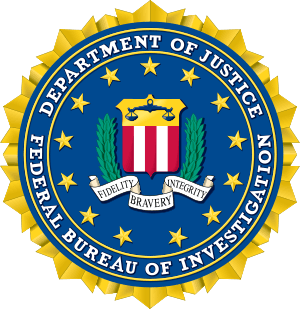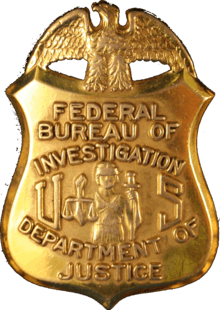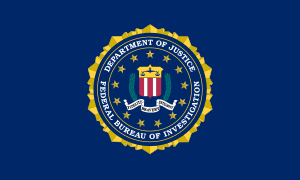FBI Laboratory
| Federal Bureau of Investigation | |||||||||||||||||||||||||||||||||||||||||||||||||||||||||||
|---|---|---|---|---|---|---|---|---|---|---|---|---|---|---|---|---|---|---|---|---|---|---|---|---|---|---|---|---|---|---|---|---|---|---|---|---|---|---|---|---|---|---|---|---|---|---|---|---|---|---|---|---|---|---|---|---|---|---|---|
| Common name | Federal Bureau of Investigation | ||||||||||||||||||||||||||||||||||||||||||||||||||||||||||
| Abbreviation | FBI | ||||||||||||||||||||||||||||||||||||||||||||||||||||||||||
|
| |||||||||||||||||||||||||||||||||||||||||||||||||||||||||||
| |||||||||||||||||||||||||||||||||||||||||||||||||||||||||||
The FBI Laboratory is a division within the United States Federal Bureau of Investigation that provides forensic analysis support services to the FBI, as well as to state and local law enforcement agencies free of charge. The lab is currently located at Marine Corps Base Quantico in Quantico, Virginia. Opening November 24, 1932,[2] the lab was first known as the Technical Laboratory. It became a separate division when the Bureau of Investigation (BOI) was renamed in the FBI.
From September 1934 to September 1975, the Lab was located on the 6th floor and the attic of Justice Department Building in Washington, D.C. Public tours of the lab work area were available until the FBI moved across the street to the newly constructed J. Edgar Hoover Building in 1974. Tours of the J. Edgar Hoover Building still were available, but the route the tour moved away from the lab work space thus sealing the lab from public view. The laboratory expanded to such an extent that the Forensic Science Research and Training Center (FSRTC) was established at the FBI Academy in Quantico, Virginia. Methods at the FSRTC helped establish standardized forensic practices for law enforcement agencies. The FBI Lab has been in Quantico since the transition from Washington around 2004.
It is a full-service operation, with some 500 scientific experts and special agents. The lab generally enjoys the reputation as the premier crime lab in the United States. However, during the 1990s, its reputation and integrity came under withering criticism, primarily due to the revelations of Special Agent Dr. Frederic Whitehurst, the most prominent whistleblower in the history of the Bureau. Whitehurst was a harsh critic of conduct at the Lab, coming to believe that a lack of funding and a pro-prosecution bias of the Lab technicians, who were FBI agents first and forensic scientists secondly due to the institutional culture of the Bureau, had caused the tainting of much evidence.
History
According to John F. Kelly & Phillip K. Wearne's 1998 book Tainting Evidence: Inside the Scandals at the FBI Crime Lab, the FBI Crime Lab had been hurt by a lack of funding and an institutional entropy rooted in Lab employees' belief that they were the best forensic experts in the country, if not the world. Lab employees failed to keep abreast of developments in forensic science. The two authors conclude that the worst problem was that the Lab employees were FBI agents rather than pure forensic scientists, and the investigative paradigm of the detective was an antithetical to the investigative paradigm of the scientist. Lab employees began to work backwards, from a conclusion preordained by the prosecutors they served, and sought to justify that conclusion rather than using more scientific research paradigms.
Whitehurst's whistleblowing and the adverse publicity trials in which FBI Lab employees were revealed as incompetent or disingenuous led to the implementation of reforms under then–FBI chief Louis Freeh.
Controversy
The history of the FBI Lab has not been without controversy. Dr. Frederic Whitehurst, who joined the FBI in 1982 and served as a Supervisory Special Agent at the Lab from 1986 to 1998, blew the whistle on scientific misconduct at the Lab. In a subsequent investigation, it was found that evidence had been falsified, altered, or suppressed, or that FBI agents had testified falsely, in as many as 10,000 cases, resulting in many false convictions. More than a decade later, cases were still being overturned because of this massive fraud.[3] As a result of Whitehurst's whistleblowing, the FBI Lab implemented forty major reforms, including undergoing an accreditation process.
References
- 1 2 3 "Frequently Asked Questions". Federal Bureau of Investigation. Retrieved 2016-09-02.
- ↑ "FBI Laboratory History". Federal Bureau of Investigation.
- ↑ Washington Post Calls for Full Review of FBI Crime Lab
External links
- The FBI Laboratory: An Investigation into Laboratory Practices and Alleged Misconduct in Explosives-Related and Other Cases (April 1997)
- Frederic Whitehurst's criticism of Unabomber investigation
- Frederic Whitehurst's criticism of World Trade Center bombing investigation


